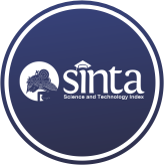Rancang Bangun Aplikasi Diagnosa Kerusakan Komputer dengan Sistem Pakar Metode Forward Chaining
(1) STMIK Jakarta STI&K, Jakarta Selatan, Indonesia
(2) STMIK Jakarta STI&K, Jakarta Selatan, Indonesia
(3) Universitas Gunadarma, Jawa Barat, Indonesia
(*) Corresponding Author
Abstract
Full Text:
PDFReferences
B. H. Hayadi, Sistem Pakar. Deepublish, 2018.
H. Listiyono, “Merancang Dan Membuat Sistem Pakar,” Dinamik, Vol. 13, No. 2, Art. No. 2, 2008, Doi: 10.35315/Dinamik.V13i2.76.
R. Rosnelly And U. P. Utama, Sistem Pakar: Konsep Dan Teori. Penerbit Andi.
P. S. R. M.Kom And U. F. S. P. M.Kom, Mengenal Metode Sistem Pakar. Uwais Inspirasi Indonesia.
M. Ipan And T. Oktarina, “Application Of The Iterative Model In Designing An Academic E-Counseling System At Bina Darma University,” J. Tek. Inform. Jutif, Vol. 4, No. 1, Art. No. 1, Feb. 2023, Doi: 10.52436/1.Jutif.2023.4.1.838.
N. Dwivedi, D. Katiyar, And G. Goel, “A Comparative Study Of Various Software Development Life Cycle (Sdlc) Models,” Int. J. Res. Eng. Sci. Manag., Vol. 5, No. 3, Art. No. 3, Mar. 2022.
K. Rokoyah, Y. I. Chandra, And S. Lukman, “Penerapan Model Incremental Dalam Merancang Aplikasi Pengenalan Bentuk Dan Fungsi Gigi Pada Manusia Berbasis Web,” J. Sikomtek, Vol. 12, No. 2, Art. No. 2, Jul. 2022.
N. P. Ayudhana, L. Andrawina, And A. Musnansyah, “Perancangan Dan Pembangunan Knowledge Management System Pada Modul Pengabdian Masyarakat Dan Penunjang Menggunakan Framework Codeigniter Dengan Metode Iterative Incremental,” Eproceedings Eng., Vol. 2, No. 2, Art. No. 2, Aug. 2015, Doi: 10.34818/Eoe.V2i2.2192.
P. Abrahamsson, N. Oza, And M. T. Siponen, “Agile Software Development Methods: A Comparative Review1,” In Agile Software Development: Current Research And Future Directions, T. Dingsøyr, T. Dybå, And N. B. Moe, Eds., Berlin, Heidelberg: Springer, 2010, Pp. 31–59. Doi: 10.1007/978-3-642-12575-1_3.
M. Riesener, C. Doelle, S. Perau, P. Lossie, And G. Schuh, “Methodology For Iterative System Modeling In Agile Product Development,” Procedia Cirp, Vol. 100, Pp. 439–444, Jan. 2021, Doi: 10.1016/J.Procir.2021.05.101.
J. Lin, K. H. Chai, Y. S. Wong, And A. C. Brombacher, “A Dynamic Model For Managing Overlapped Iterative Product Development,” Eur. J. Oper. Res., Vol. 185, No. 1, Pp. 378–392, Feb. 2008, Doi: 10.1016/J.Ejor.2006.12.022.
B. Blocken And C. Gualtieri, “Ten Iterative Steps For Model Development And Evaluation Applied To Computational Fluid Dynamics For Environmental Fluid Mechanics,” Environ. Model. Softw., Vol. 33, Pp. 1–22, Jul. 2012, Doi: 10.1016/J.Envsoft.2012.02.001.
DOI: https://doi.org/10.30645/kesatria.v5i1.320
DOI (PDF): https://doi.org/10.30645/kesatria.v5i1.320.g317
Refbacks
- There are currently no refbacks.
Published Papers Indexed/Abstracted By:














